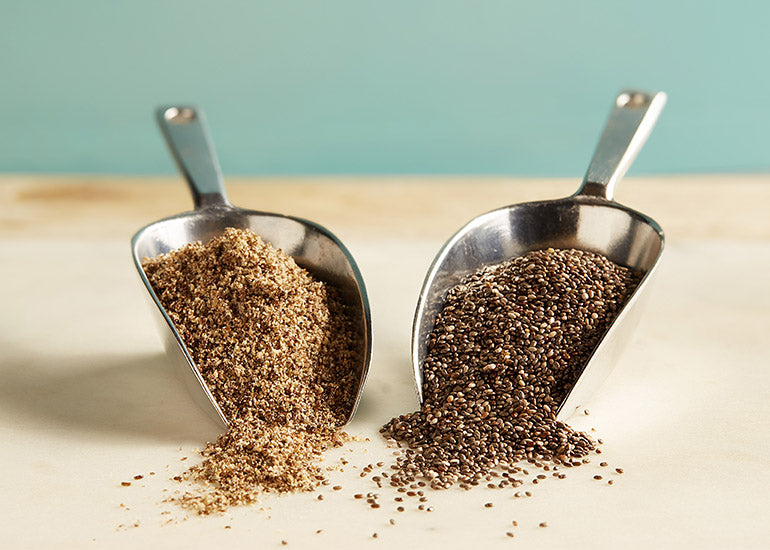From chia seed pudding to smoothies, chia has become a popular superfood utilized in an assortment of recipes. If you've used the edible seed before, you may have noticed that the chia seed can actually be found in both seed and powder form. Considering the ingredients of both chia powder and chia seeds are one and the same—chia—many people assume that both products can be used interchangeably, which is an understandable assumption! Chia seeds are nothing more than the whole, raw seeds, while chia powder is created by grinding up these seeds into a fine powder. For those looking to incorporate this nutrient-dense superfood into their diet, explore our premium chia seeds available on our product page.
From a technical standpoint, that's the only difference between the two (there is no nutrition or absorption difference). Yet, because each product has such a separate role in the kitchen, you may want to consider actually having both of these superfood ingredients on hand.
Chia Benefits
Despite their tiny and unassuming look, organic chia seeds are rich in nutrients, making them a popular keto superfood. Since chia seeds and chia powder are essentially one and the same, it's important to consider the health benefits gained from incorporating either into your diet.
1. Organic Chia Seeds are High in Fiber
One serving (two and a half tablespoons) of Navitas Organics Chia Seeds contains nine grams of fiber, which is 30% of your daily recommended intake. Fiber supports gut health by promoting the flow of materials through the digestive organs.
2. Rich with Antioxidants
Antioxidants help fight free radicals that can damage cells in the body and weaken immunity. A diet containing foods rich in antioxidant content also supports healthy and resilient skin, hair, and nails.
3. High in Omega-3 Fatty Acid Content
Omega-3 fatty acids have powerful health benefits for the brain and body. Omega-3s have been scientifically shown to reduce inflammation and support healthy blood pressure levels in those with high blood pressure. Side note: Hemp seeds are also a great option for upping your intake of omega-3 fatty acids!
With an understanding of the nutritional benefits of the chia seed, let's take a closer look at specifically how they're used.
Versatile Whole Chia Seeds
Whole chia seeds are one of the most versatile superfoods on the planet. When used straight out of the bag, their small size and mild flavor make them an unnoticeable addition to just about any kind of dish. You can sprinkle chia seeds on salads, garnish some pasta or swirl them into yogurt—they can go everywhere!
Aside from dry chia seeds' versatility, chia seeds are also hydrophilic, meaning they absorb water when soaked. When surrounded in liquid for as little as 15 minutes, they develop a jelly-like coating and can expand up to 10 times their normal size! These swollen chia seeds (aka chia gel) are often used as a fun textural agent in things like sauces and drinks, and it’s this same feature that makes chia seeds so slippery and fun to eat.
Flavorful Chia Powder
When the chia seeds are ground into a powder, you'll notice some surprising changes. The first difference is the flavor: chia powder exhibits a slightly stronger nutty flavor over whole chia seeds (although, it is still relatively mild). This enhancement is simply due to the chia oils being more exposed, so our taste buds have a better chance to explore them. Ground chia is also much finer, so it's not quite as conducive to the ubiquitous garnish feature that whole chia enjoys (just the way you might top a salad with almonds, but not with almond flour).
What Sets Them Apart
Perhaps the biggest difference between the two forms of chia is found back in the subject of it being a gelatinous food. When whole chia seeds are hydrated, each seed attracts liquid to itself, forming an individual gel “bubble,” which is what makes it slippery. When ground chia seeds are hydrated, rather than a bubble, the entire surrounding liquid is infused with this gelatinous material, thickening the liquid mixture as a whole. This is why ground chia seeds are considered to be a binder, like eggs, in baking recipes, whereas whole chia seeds are not. Therefore, the best way to use chia powder is in liquids that need to be thickened and baking recipes that need binding (and, of course, as a superfood boost). Navitas Organics Chia Powder makes an especially great egg replacement in batters for vegan pancakes and baked goods!
Incorporating Chia Seeds into Daily Meals
Chia seeds are fantastically adaptable and can find their way into countless dishes, offering an easy path to daily nutrient intake. Whole chia seeds can be sprinkled onto salads and soups, stirred into oatmeal and yogurt, or mixed into liquids for satiety and improved hydration. Ground chia seeds are an easy choice for smoothies, baked goods, puddings, energy bites, and crackers. Whichever form you choose, you can count on chia to add a healthy boost of protein, fiber, and omega-3 fatty acids to your day!
Nutritional Differences Between Chia Seed Forms
When exploring the differences between ground chia seeds and whole chia seeds, the key focus should be on digestibility and nutrient absorption. Whole chia seeds may sometimes pass through the digestive tract without fully breaking down, whereas ground chia seeds provide better nutrient accessibility. The grinding process cracks open the seeds, giving you easier access to the powerful nutrients they contain, including fiber, omega-3 fatty acids, and antioxidants. As a result, nutrients like ALA and fiber become more readily available when you consume ground chia seeds. Thus, incorporating ground chia seeds into your diet can enhance digestion, ensuring you derive maximum health benefits from these small but mighty seeds.
|
Feature |
Chia Seeds (Whole) |
Chia Powder (Ground) |
|
Nutrient Content |
High in omega-3s, fiber, and protein |
Same nutrients as whole seeds |
|
Nutrient Bioavailability |
Nutrients may be less available due to the whole seed form |
Easier absorption; nutrients are more accessible when ground |
|
Superfood Benefits |
Excellent for slow digestion and steady energy |
Excellent for nutrient uptake and energy without added bulk |
All differences aside, you can always feel confident that however you choose to enjoy it, chia is one of the most nutritious superfoods nature has to offer! Check out the recipe section of our website for some of our favorite ways to use both chia seeds and chia powder.
References:
Pizarro, P. L., Almeida, E. L., Samman, N. C., & Isla, M. I. (2023). Characterisation of physicochemical and functional properties of chia (Salvia hispanica L.) hydrocolloids. Food & Function, 14(3), 1398–1410. https://doi.org/10.1039/D2FO03002K
Ullah, R., Nadeem, M., Khalique, A., Imran, M., Mehmood, S., Javed, K., & Hussain, J. (2016). Nutritional and therapeutic perspectives of chia (Salvia hispanica L.): a review. Journal of Food Science and Technology, 53(4), 1750–1758. https://doi.org/10.1007/s11130-016-0543-8
Mohd Ali, N., Yeap, S. K., Ho, W. Y., Beh, B. K., Tan, S. W., & Tan, S. G. (2012). The promising future of chia, Salvia hispanica L. Journal of Biomedicine and Biotechnology, 2012, Article ID 171956. https://doi.org/10.1155/2012/171956
)

